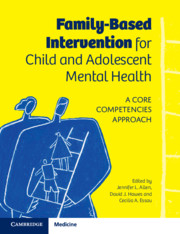Book contents
- Family-Based Intervention for Child and Adolescent Mental Health
- Family-Based Intervention for Child and Adolescent Mental Health
- Copyright page
- Contents
- Contributors
- Preface
- Part I Theoretical Perspectives on Family-Based Intervention
- Chapter 1 A Core-Competency Perspective on Family-Based Intervention for Child and Adolescent Mental Health
- Chapter 2 The Role of the Family in Child and Adolescent Psychopathology
- Chapter 3 Implementation of Family-Based Intervention
- Chapter 4 Effective Components of Parenting Programmes for Children’s Conduct Problems
- Part II Core Clinical Competencies
- Part III Family Intervention for Specific Child and Adolescent Mental Health Problems
- Part IV Family Intervention for Children at Risk Due to Family Dysfunction or Past Adversity
- Part V New Developments in Family-Based Intervention
- Index
- References
Chapter 4 - Effective Components of Parenting Programmes for Children’s Conduct Problems
from Part I - Theoretical Perspectives on Family-Based Intervention
Published online by Cambridge University Press: 18 February 2021
- Family-Based Intervention for Child and Adolescent Mental Health
- Family-Based Intervention for Child and Adolescent Mental Health
- Copyright page
- Contents
- Contributors
- Preface
- Part I Theoretical Perspectives on Family-Based Intervention
- Chapter 1 A Core-Competency Perspective on Family-Based Intervention for Child and Adolescent Mental Health
- Chapter 2 The Role of the Family in Child and Adolescent Psychopathology
- Chapter 3 Implementation of Family-Based Intervention
- Chapter 4 Effective Components of Parenting Programmes for Children’s Conduct Problems
- Part II Core Clinical Competencies
- Part III Family Intervention for Specific Child and Adolescent Mental Health Problems
- Part IV Family Intervention for Children at Risk Due to Family Dysfunction or Past Adversity
- Part V New Developments in Family-Based Intervention
- Index
- References
Summary
Parenting programs for children’s conduct problems are among the more ‘mature’ family-based interventions – more than 150 randomized trials and dozens of meta-analyses confirm their ability to reduce observed and parent-reported conduct problems. However, few programs are actually taken to scale, especially in times of health-care budget cuts and lower resource settings because many programs are complex and costly to implement. Recent developments to identify the effective components of parenting programs hold promise to fill the gap between existing complex evidence-based programs and the need for effective low-cost and easy-to-implement programs. This chapter provides an overview of these developments and their main findings.
- Type
- Chapter
- Information
- Family-Based Intervention for Child and Adolescent Mental HealthA Core Competencies Approach, pp. 40 - 52Publisher: Cambridge University PressPrint publication year: 2021
References
- 1
- Cited by



